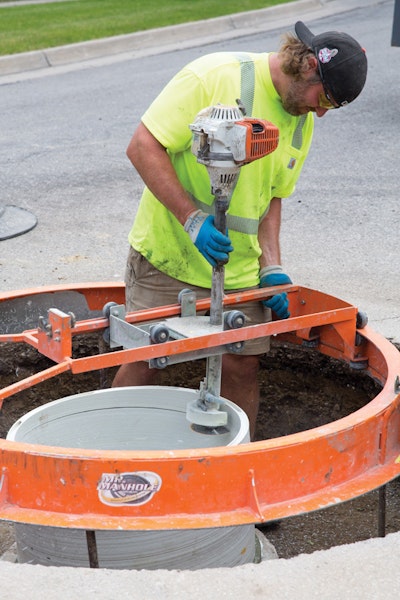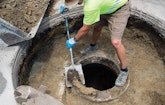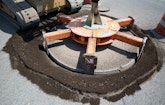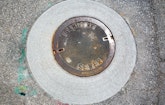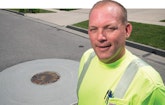
P.J. Hachey (left) and laborer Max Rosener move the top of the new manhole into place with Brad Steenhoek watching.
Interested in Relining/Rehab?
Get Relining/Rehab articles, news and videos right in your inbox! Sign up now.
Relining/Rehab + Get AlertsDiversification drives growth for many companies, but Cedar Rapids, Iowa-based Save Our Sewers has taken a different approach. The company focuses on one service, and does it well.
Specializing in manhole rehabilitation hasn't hindered the company's growth. Instead, it's quite the opposite.
“I’m now doing about 10 times the revenue I was doing in year one. Basically my business has doubled every year,” says company owner Brad Steenhoek. “It’s still kind of a new market and now that I’ve been in it long enough, I’m probably one of the lowest-cost operators out there with the highest capacity. A lot of people still can’t do it at our prices because of how we’re set up.”
A recent job in Ames, Iowa, shows how much Steenhoek has been able to grow his business by focusing on one specific — but much needed — service. Save Our Sewers has been doing work in Ames since 2010, but beginning in the fall of 2015, the city had a single contract that called for rehabbing 650 manholes, both on roadways and grassy areas.
“It’s by far the largest we’ve taken on,” Steenhoek says. “We’d done projects before where it was 100 to 200 manholes, but never 500-plus.”
Branching off the stimulus
Steenhoek started Save Our Sewers in 2010, but he was already familiar with the industry, having sold utility products like concrete pipe and precast manholes going back to 2002. That background helped him notice the opportunity that arose when the American Recovery and Reinvestment Act was enacted in 2009. Municipalities geared up to spend the extra dollars on infrastructure rehab projects, and Steenhoek says he thought it was a good time to stop selling new products and establish a service business instead. At that time, he hadn’t yet planned on developing a niche with manhole rehab specifically. He just knew rehab was the direction to go.
“Having worked with DOTs and various cities, I knew a lot of the work was going to be redoing existing infrastructure rather than building things from scratch, and that’s why I got out of what I was selling. There was going to be more retrofit work than new projects,” he says.
The same month the stimulus package was signed, Steenhoek attended what is now called the Water & Wastewater Equipment, Treatment & Transport Show in Louisville, Kentucky.
“I truthfully went to Louisville trying to find something that was different than what everybody else was doing,” he says. “I went to that show with a checkbook and line of credit, and determined what I wanted to do.”
It was at that 2009 show that Steenhoek had his first exposure to the Mr. Manhole rehab system and realized that might be the niche he was seeking.
“Everyone has manholes and everyone has issues with them,” he says. “Companies that are mainline rehab contractors typically do not do structural rehab work, so I knew manholes were pretty much a slam dunk. With the stimulus and all the mill and overlay work that would be occurring, there would be a big need for manhole rehab on the chimney area.”
Following the show, Steenhoek spent several more months doing research, eventually purchasing the Mr. Manhole system and the rest of his equipment later in the year. By February 2010 he had incorporated as Save Our Sewers.
Challenges of niche work
Although Steenhoek knew there was a big opportunity in manhole rehab, there were still challenges getting his young company established.
“Having all your eggs in one basket and being a highly specialized contractor, the biggest challenge was that a lot of my potential customers were self-performing this work with their own crews and equipment. My competition was basically my customers,” he says. “I had to prove to them that I could do it better and at a lower cost than what they could.”
Steenhoek spent a lot of time in the beginning on education, doing demonstrations of the Mr. Manhole method for municipalities and engineering firms to show them how reliable and cost-effective the system could be. Over time he gained a foothold in the market.
“There are a lot of municipalities now that have seen the Mr. Manhole tool, and they’ve seen the rebuild process and the materials that go along with it,” he says. “It’s sometimes the only thing they’ll allow because it’s a standardized process with good raw materials. There was no standardization with how a lot of these guys were doing it before. It was just find whatever you can in the back of your pickup truck, throw it on the ground and pour some concrete or asphalt around it.”
The Mr. Manhole process uses a dry-cut saw that runs on a standard skid-steer or track loader. It cuts a circle through the road surface surrounding the manhole frame and is able to cut from 44 to 58 inches — 28 to 72 inches with the aid of adapters — up to 48 inches deep. The cylinder strength of the ready-mix pour is all that is needed once the manhole is rebuilt.
“Round holes are a structurally superior design versus a square cut around these manhole frames and covers, and it uses less material and looks better,” Steenhoek says. “You do the work and you pour it. There are no internal chimney seals, no epoxies or coatings. It kind of sells itself. Once an engineer sees it, it’s an attitude of, ‘Wow, where has this been? Why isn’t everybody doing it this way?’”
Since that initial startup and education phase, Steenhoek has largely relied on repeat business. He has established relationships with firms that regularly use him as they move among various communities to do projects.
“They take the specs and just apply it to the next community,” Steenhoek says. “It’s been a sort of snowball effect where I started off small, but now I’m having a hard time just keeping up with the work that specifies Mr. Manhole.”
Mr. Manhole isn’t the only process Save Our Sewers employs, but Steenhoek estimates that it ends up handling about 90 percent of the company’s workload.
“All of my men are PACP, MACP and LACP certified. When we open up the lid, we already know what’s allowed in the project specs and then we can determine the best rehab method based on the NASSCO training we all have,” he says. “The only thing consistent in this business is how inconsistent every manhole is put together. There are no two manholes alike.”
Working in the public sector
Establishing a business solely around public sector clients has also proven challenging in certain ways for Steenhoek.
“This is an emerging market but, like anything, there’s a learning curve,” he says. “If there are guys thinking they’re going to quit their day job doing something like building houses and get into this, they’re going to learn a lot really fast. Working in the public sector is completely different than working in the private sector. Having a good background with municipalities and utility work and utility products going in helped me a lot.”
The primary challenge, Steenhoek says, is maintaining consistent cash flow.
“Getting paid can be hard when you’re dealing with city councils and mayors. The cash is definitely slow. You’re lucky to see your money in 60 days,” he says. “It takes a large line of credit to operate off of, which is kind of scary. There are months where I have $300,000 out there. I’m paying help, I’m paying suppliers, I’m paying bills, I’m paying for rooms and per diems. It is what it is. You get to the good summer months and you’re running a lot of overtime and a lot of payroll. It doesn’t take long to spend a couple hundred thousand dollars.”
That’s why Steenhoek says he’s careful not to grow beyond what the current market climate allows. He borrows money, adds equipment, and hires more employees alongside the amount of work available to bid on. And he makes sure the company is in as good a position as possible to win those bids.
“The big thing is you don’t want to lose opportunities,” he says. “From the bid standpoint, you have to know the specifications and what the engineers are learning, and be able to adapt to all that.”
The cash flow situation has also made it important for Save Our Sewers to stay busy year-round despite providing a service that isn’t always winter-friendly in Iowa. To do that, Steenhoek looks for opportunities to travel for work outside the usual service area (about a 250-mile radius around Cedar Rapids) where winter weather doesn’t have as much of an impact on manhole rehab.
“It’s usually January through March 1. That’s normally when I look to travel, when there’s snow on the ground,” Steenhoek says.
For example, in February 2012, he spent two weeks in Geelong, Australia, because of his connections with Mr. Manhole.
“We were setting up installers over there and a distributor network, and got them going with equipment and training, and actually went out and did some work. Mr. Manhole handled the equipment side of things, but we were the ones who went over there and added the human element to everything,” he says.
Big project in Ames
The Ames contract the company took on in October 2015 showcases how much Save Our Sewers has been able to benefit from focusing solely on manhole rehab. Aided by past experience using the Mr. Manhole method effectively in the city, Steenhoek was the choice when officials decided to do a large-scale project.
The contract called for 421 roadway manholes and another 100 in grassy areas. Thanks to a fairly mild winter that didn’t have too many workdays missed due to snow or rain, Save Our Sewers had the contract wrapped up in May. And Ames extended the contract when Save Our Sewers came in under the bid amount because of savings on concrete use.
“Because of the savings of going circular versus a rectangle or square structure, we were way under on our concrete usage,” Steenhoek says. “We saved about $200,000, so they extended it from the original bid quantity and we did about 650 manholes when it was all said and done.”
The complete project finished at the end of June, well under the yearlong timetable Ames officials wanted to adhere to. Save Our Sewers ran two three-man crews with Steenhoek working between them. The Mr. Manhole method was used, as well as other processes and systems like chemical grouting, the Pro-Ring from Cretex Specialty Products, and Riser-Wrap (GPT Industries). East Jordan Iron Works out of Michigan supplied manhole frames and covers.
“It was a full-blown rehab,” Steenhoek says. “After setting up traffic control, and getting everything cut, rebuilt and poured, there were times we did up to 11 manholes a day. The average was about five or six a day.”
The future
Save Our Sewers doesn’t currently have any plans to expand beyond the manhole rehab business. Steenhoek says he’s still growing steadily with his sole service offering, and he also doesn’t want current allies suddenly turning into competitors.
“The CIPP guys, all they want to do is clean and line between manholes, and they subcontract out all the vertical structure work,” he says. “I really don’t want to get into the mainline lining because I don’t want to step on their toes and I don’t want them getting into what I do.”
In addition to the manhole rehab specialty providing Steenhoek a solid livelihood, he views it as his way to practice environmental stewardship.
“There’s a lot of work out there between the EPA and the DNR, and all the water-quality studies that are going on basically from the Gulf Region up to the Mississippi River watershed,” Steenhoek says. “In Iowa, we have a huge nitrate issue with fertilizer runoff, so there’s a big push to clean up the waters. It’s the whole country, and we’re trying to do our part to make it a better place.”
